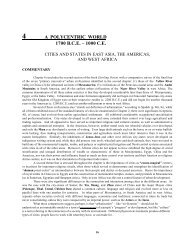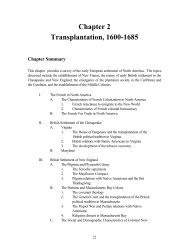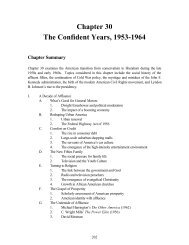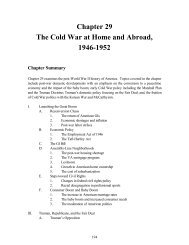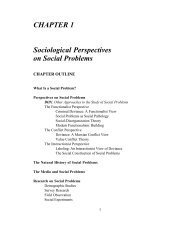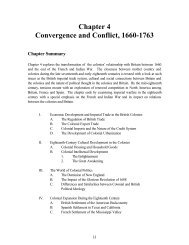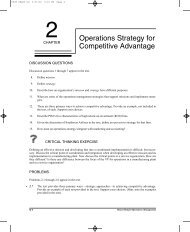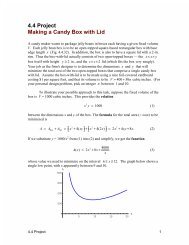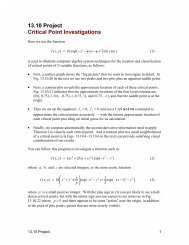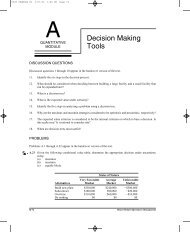Merchandising Operations and the Accounting Cycle - Pearson
Merchandising Operations and the Accounting Cycle - Pearson
Merchandising Operations and the Accounting Cycle - Pearson
You also want an ePaper? Increase the reach of your titles
YUMPU automatically turns print PDFs into web optimized ePapers that Google loves.
Journal<br />
Adjusting Entries<br />
a. Dec. 31 Interest receivable ................................................ 400<br />
Interest revenue .............................................. 400<br />
b. Dec. 31 Cost of goods sold................................................ 300<br />
Inventory.......................................................... 300<br />
c. Dec. 31 Supplies expense ($650 – $100) .......................... 550<br />
Supplies............................................................ 550<br />
d. Dec. 31 Insurance expense................................................ 1,000<br />
Prepaid insurance ........................................... 1,000<br />
e. Dec. 31 Amortization expense—furniture ..................... 600<br />
Accumulated amortization—furniture........ 600<br />
f. Dec. 31 Unearned sales revenue ...................................... 1,300<br />
Sales revenue................................................... 1,300<br />
g. Dec. 31 Wages expense...................................................... 400<br />
Wages payable................................................. 400<br />
h. Dec. 31 Interest expense.................................................... 200<br />
Interest payable............................................... 200<br />
Closing Entries<br />
Dec. 31 Sales revenue .................................................... 169,300<br />
Interest revenue ................................................ 1,000<br />
Income summary ........................................ 170,300<br />
Dec. 31 Income summary.............................................. 116,450<br />
Cost of goods sold....................................... 90,800<br />
Sales discounts............................................. 1,400<br />
Sales returns <strong>and</strong> allowances..................... 2,000<br />
Wages expense............................................. 10,200<br />
Rent expense ................................................ 8,400<br />
Amortization expense—furniture ............ 600<br />
Insurance expense....................................... 1,000<br />
Supplies expense ......................................... 550<br />
Interest expense........................................... 1,500<br />
Dec. 31 Income summary ($170,300 – $116,450) ........ 53,850<br />
Retained earnings........................................ 53,850<br />
Dec. 31 Retained earnings............................................. 54,100<br />
Dividends..................................................... 54,100<br />
Learning Tip Here is an easy way to remember <strong>the</strong> closing process. First, look<br />
at <strong>the</strong> work sheet. Then:<br />
1. Debit all income statement accounts with a credit balance. Credit Income<br />
Summary for <strong>the</strong> total of all <strong>the</strong>se debits.<br />
2. Credit all income statement accounts with a debit balance. Debit Income<br />
Summary for <strong>the</strong> total of all <strong>the</strong>se credits.<br />
3. Take <strong>the</strong> balance in <strong>the</strong> Income Summary account. If <strong>the</strong> account has a debit<br />
balance, <strong>the</strong>re is a net loss; credit Income Summary for that amount, <strong>and</strong> debit<br />
Retained Earnings. If Income Summary has a credit balance, <strong>the</strong>re is a net income;<br />
debit Income Summary for that amount, <strong>and</strong> credit Retained Earnings.<br />
4. Look at <strong>the</strong> debit balance of Dividends in <strong>the</strong> balance sheet column. Credit<br />
Dividends for its balance, <strong>and</strong> debit Retained Earnings for <strong>the</strong> same amount.<br />
Income Statement Formats:<br />
Multi-Step <strong>and</strong> Single-Step<br />
We have seen that <strong>the</strong> balance sheet appears in two formats: <strong>the</strong> report format (assets<br />
on top, shareholders’ equity at <strong>the</strong> bottom) <strong>and</strong> <strong>the</strong> account format (assets at left,<br />
EXHIBIT 5-8<br />
Adjusting <strong>and</strong> Closing Entries<br />
for a Merch<strong>and</strong>iser<br />
For a review of balance sheet<br />
formats see Chapter 4, page 177.<br />
Chapter Five <strong>Merch<strong>and</strong>ising</strong> <strong>Operations</strong> <strong>and</strong> <strong>the</strong> <strong>Accounting</strong> <strong>Cycle</strong> 243



